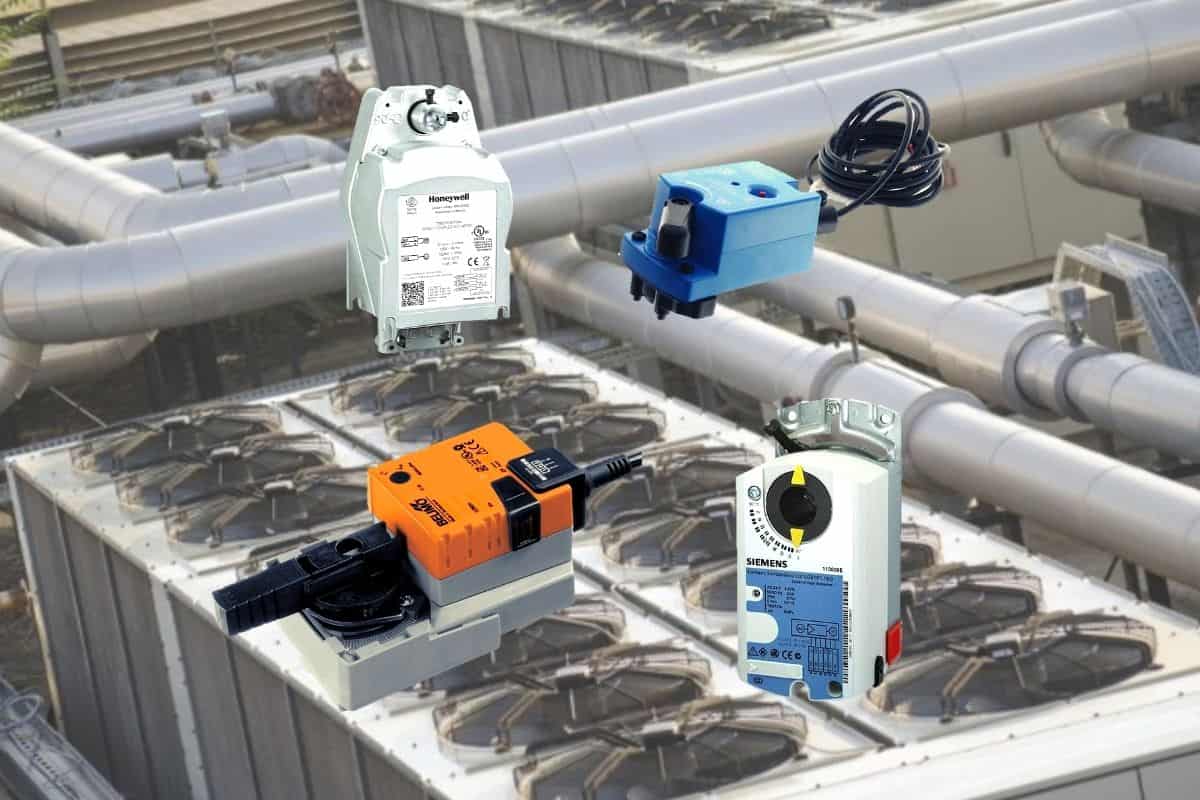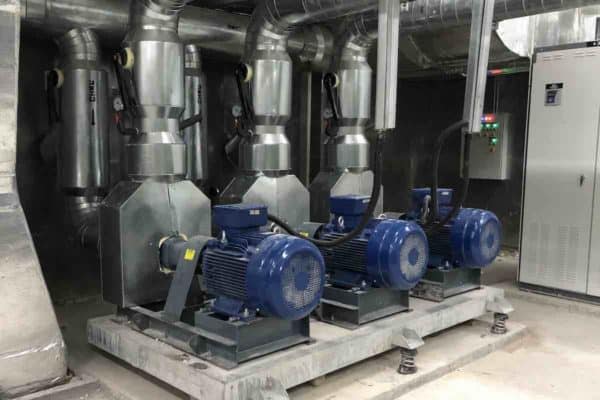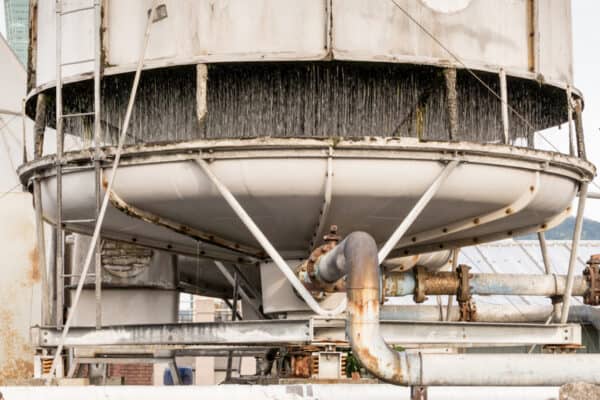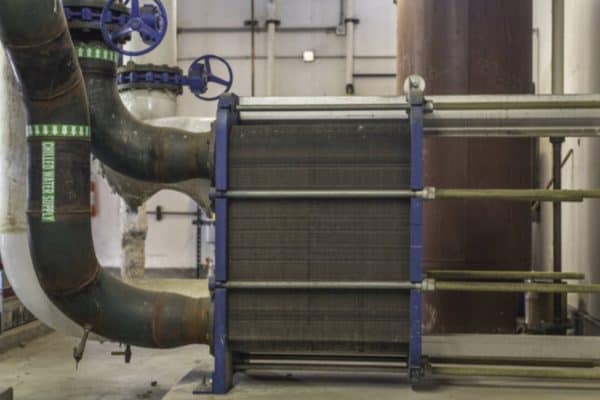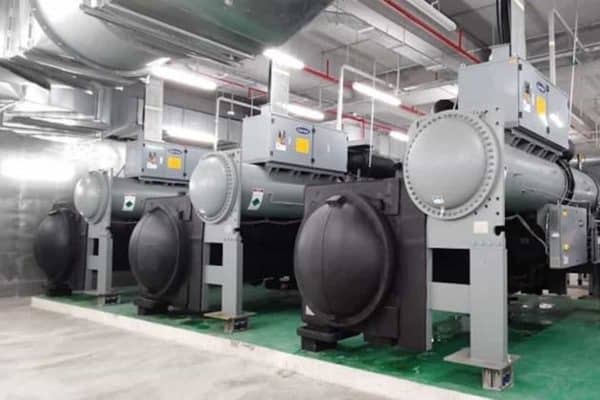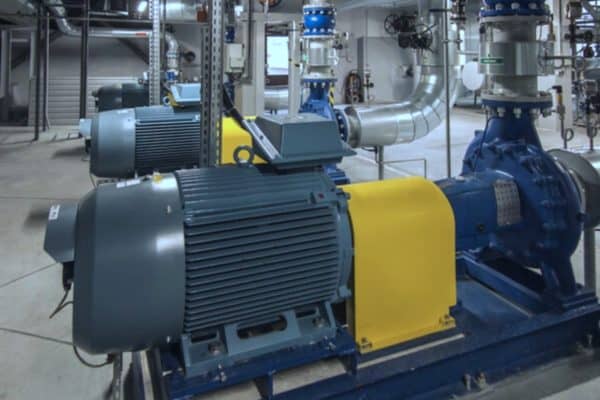4 Types of Actuators in HVAC (Damper & Valve)
There are many different types of actuators used in HVAC dampers and valves. Actuators also have many different specifications for different applications and requirements. So, I organized 4 common types of actuators used in HVAC and then elaborate them further so that people can understand better.
Actuators are small motor devices that use little power to turn HVAC dampers or valves open/close. When used with dampers, they control airflow. When used with valves, they often control the water flow rate.
The 4 common types of actuators in HVAC are as follow:
- Spring Return On/Off Actuator
- Air Volume Modulating Actuator
- Chilled Water On/Off Actuator
- PIBCV Modulating Actuator
In my opinion, people are not paying enough attention to actuators. Actuators are extremely important in HVAC systems.
For instance, actuators need to close fire dampers fast enough and under high temperatures during a fire to save lives. Moreover, actuators are responsible for the chilled water flow control and thus, the energy efficiency of air conditioners.
Before we start, the 4 common types of actuators are not fixed by the name I’ve given. Instead, they are based on what we used to call them. Most people working in the HVAC industry more or less understand what you’re talking about when you call an actuator by the combined name I listed in this post.
With that said, let’s dive into the 4 common types of actuators used in HVAC systems.
1. Spring Return On/Off Actuator

Spring return on/off actuators are mostly used for the fire & smoke damper in HVAC systems. A fire & smoke damper is a piece of damper that has the ability to prevent fire and smoke from passing through. On the other hand, a fire damper is only capable of stopping fire but not smoke.
Fire & smoke dampers are more commonly found in the pressurization system and the smoke extraction system in the HVAC system of buildings. They also can be found at the wall where there is a penetration of duct.
Generally, this type of actuator has the following characteristics:
- Must be fire resistance
- Must act fast
- Must have fail safe
- Can be on/off or modulating type
Applications:
- Motorized fire damper
- Motorized fire & smoke damper
I name this type of actuator as spring return on/off actuator because it is the most common specification for motorized fire dampers and motorized fire & smoke dampers.

Must be fire resistance
During a fire, fire & smoke dampers are required to close in order to prevent fire and smoke spreads from one room to another. At the same time, certain fire & smoke dampers are required to stay open in order to maintain pressure and prevent smoke from entering into escape stairwells and lift lobbies.
In order for actuators to work under extreme heat conditions, they must meet UL555 (fire) or UL555S (fire & smoke) standards at 350°F (176°C). In another word, both fire & smoke dampers and actuators must be able to work up to 350°F (176°C).
If an actuator melts during a fire and fails to close the damper, the entire pressurization system could fail to prevent smoke from entering escape routes and the consequences are unimaginable.
Must act fast
This type of actuator must close very fast. Hence, spring return actuators are used for fire & smoke dampers.
Basically, spring return actuators open the damper via an electrical power/signal to allow air to pass through during normal operation. During a fire, the said electrical power/signal is cut off and thus, a mechanical spring winded inside the actuator quickly spins the damper back to a close position.
Normally, spring return actuators for fire & smoke dampers call for 15 seconds closing time. It means that once the fire alarm is triggered, all applicable fire & smoke dampers must be closed within 15 seconds.
Must have fail safe
Actuators use a mechanical spring to close rather than an electrical signal/power in order to be fail safe. During an emergency, things such as faulty relays and burnt cables may be present. Hence, the actuator of fire & smoke dampers must be able to work independently.
High grade actuators fire & smoke dampers have an electronic fusible link. When the surrounding temperature of the actuator reaches a certain point, the actuator will spring return the damper back to a close position regardless of whether or not any electrical power/signal is being cut off.
Such actuators are sort of like having secondary protection on top of the first protection which is the mechanical spring that works independently.
Can be on/off or modulating type
Not all actuators used for fire & smoke dampers are on/off type. On/off means that actuators are either open or close only. They can’t hover in the middle.
Spring return modulating actuators are also used for fire & smoke dampers. Modulating actuators can regulate the position of the damper based on an electrical power/signal.
Usually, modulating actuators are used for pressurization systems that have variable speed fans and differential pressure sensors. Together, they are better at controlling the pressure inside stairwells and lift lobbies.
All and all, this type of actuator is used in motorized fire dampers and motorized fire & smoke dampers of all kinds of HVAC systems including the pressurization system, smoke extraction system, fresh air system and exhaust air system.
2. Air Volume Modulating Actuator
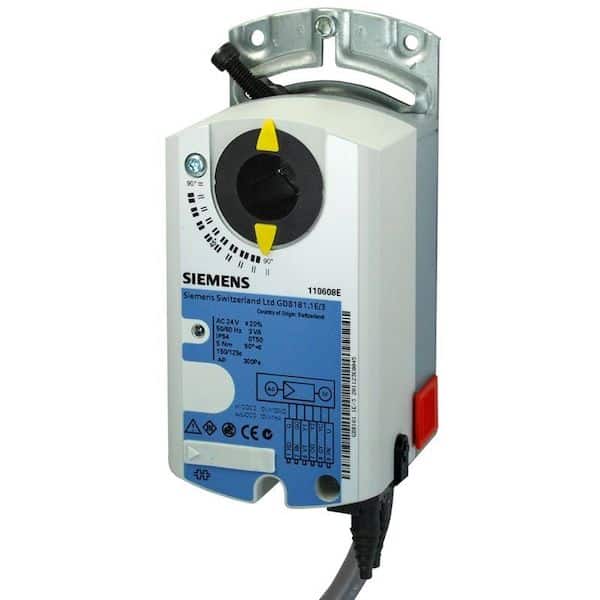
Air volume modulating actuators are used for the air volume control damper and the variable air volume (VAV) box in HVAC systems. Air volume control dampers and VAV boxes are responsible for the supply air and the return air volume control of air handling units and the fresh air and the exhaust air volume control of ventilation fans.
Generally, this type of actuator possess the following characteristics:
- Fire resistance is depending on location
- Fast acting and fail safe are not necessary
- Modulating type is preferred
- Low power consumption and low noise are preferred
- Usually have more features
Applications:
- Motorized volume control damper
- Variable air volume box
When it comes to air volume control, modulating type of actuator is more common than the on/off type.
Fire resistance is depending on location
This type of actuator is mostly not fire resistant. They are not required to respond during a fire and are not used to prevent the spread of fire and smoke. However, their installation location in HVAC systems may require them to be fire resistance just like spring return on/off actuators.
Fast acting and fail safe are not necessary
Nevertheless, air volume modulating actuators don’t need to act fast like spring return on/off actuators. Furthermore, they are more often non spring return type. They use an electrical power/signal to close as well as open.
Modulating type is preferred
Most air volume control dampers and VAV boxes require a modulating actuator so that airflow can be controlled precisely. Using an on/off actuator may result in overcooling or undercooling.
When used in the air volume control damper of fresh air systems, the actuator can be associated with carbon monoxide sensors or carbon dioxide sensors. The modulating actuator regulates the opening position of the air volume control damper to maintain good air quality.
When used in the VAV box of ducted air conditioning systems, the actuator is often associated with thermostats. The modulating actuator regulates the supply airflow based on the signal given by the thermostat to maintain a comfortable room temperature.
Low power consumption and low noise are preferred
This type of actuator constantly working to regulate airflow. Besides, there are a lot of them in a building, scattering around living spaces. Hence, low power consumption and low noise are preferred.
Usually have more features
This type of actuator usually has features such as signal feedbacks and selectable control signals. Features that ease the setup and monitoring of the actuator help a lot because there could be hundreds of air volume control actuators in a building.
In the meantime, I would like to inform you that you can learn quicker by getting my HVAC Begin (eBook) if you’re a beginner. But, if you have a year or two of experience, then I would suggest you consider my HVAC Basics (eBook). Nonetheless, I encourage you enroll in my HVAC Beginner Course: 10 Days to Become Competent in HVAC if you want to equipped yourself with a complete set of basic HVAC skills.
HVAC Beginner Course
Learn the most basics and foundational HVAC skills including cooling capacity calculation, equipment selection, duct sizing, pipe sizing, exhaust fan sizing, controls, electrical and more.
3. Chilled Water On/Off Actuator

Chilled water on/off actuators are mostly used for the ball valve and the globe valve of chilled water fan coil units. Together, they control the chilled water flow into the fan coil unit and thus, regulating the cooling and the room temperature.
Typically, a chilled water fan coil unit has one chilled water valve located right next to it. The chilled water valve has an on/off actuator that controls the amount of chilled water going into the evaporator coil based on the signal of a thermostat.
The thermostat is usually located below the ceiling to detect room temperature. When the room temperature rises above the temperature set point, the thermostat triggers an open signal to the actuator. Then, the actuator opens the chilled water valve to allow chilled water to flow into the fan coil unit to provide cooling.
When the room temperature reaches the temperature set point, the thermostat sends an off signal to the actuator. Then, the actuator closes the chilled water valve to shut off the chilled water flowing into the fan coil unit stop the cooling.
Generally, this type of actuator has a few characteristics as follow:
- Not fire resistance but water resistance
- Slow closing time
- Can be on/off or modulating type
- Low fluid temperature
- Compact size
- Low power consumption and low noise are preferred
Applications:
- Chilled water ball valve
- Chilled water globe valve
- Chilled water butterfly valve
This type of actuator is considered low-end, basic and simple. Nowadays, they are mostly found in old buildings and old HVAC systems.
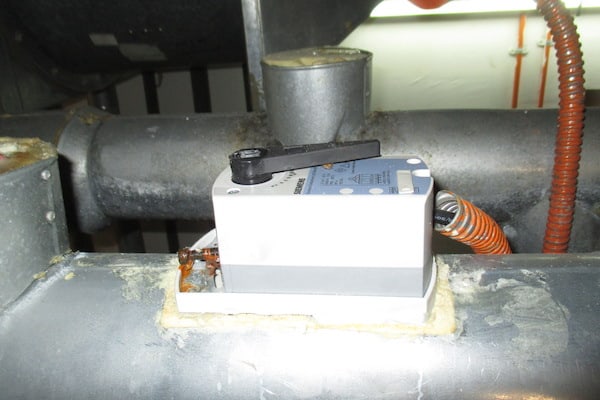
Not fire resistance but water resistance
Chilled water on/off actuators are installed mostly above the ceiling alongside their respective fan coil unit. They are not contributing to the fire system unlike spring return on/off actuators. Hence, fire resistance is not required.
Instead, chilled water actuators need to be water resistant. Although most of them are not in contact with water, there is a chance that water may splash or even burst into them due to pipe leaks. Thus, they need to be water resistant, usually at IP54.
Slow closing time
Similarly, chilled water on/off actuators don’t need to close fast like spring return on/off actuators. Some of them have a closing time of about 4 minutes as opposed to spring return on/off actuators which typically have a closing time of 15 seconds only.
By gradually closing the associated ball valve or globe valve, chilled water on/off actuators reduce the risk of water hammer. Furthermore, they allow the cooling effect to be slowly degraded instead of a sudden stop in cooling which is noticeable and uncomfortable for the people in the room.
Low fluid temperature
Chilled water is flowing at 4-7°C. So, chilled water actuators must be able to work under such a freezing condition. Although they don’t contact with chilled water, the coldness is transmitted from the valve to the actuator. Hence, chilled water on/off actuators usually have a fluid temperature of around 0°C on the low side.
Compact size
Nowadays, many chilled water on/off actuators are compact in size because they are often installed at tight spaces above the ceiling where there are many other services as well. Having a small actuator can help ease the installation and maintenance.
Low power consumption and low noise are preferred
Similar to the air volume modulating actuators, there are hundreds of chilled water air conditioning units in a building and thus, low power consumption actuators can make a significant difference in terms of electricity cost and low noise actuators provide a better working environment for the people below the ceiling.
Can be on/off or modulating type
As you may have guessed, such a control method often causes overcooling and undercooling. However, the effect is not significant when dealing with a small amount of chilled water flow.
Therefore, on/off type actuators are more often used for small capacity fan coil units rather than big capacity air handling units.
4. PIBCV Modulating Actuator

New buildings are calling for pressure independent balancing control valves (PIBCVs) nowadays. Traditional chilled water on/off valves are unable to control chilled water flow precisely enough to prevent overcooling/undercooling and energy wastage.
Therefore, PIBCV modulating actuators are used for the PIBCV of chilled water air handling units and fan coil units. As the name suggests, PIBCVs are pressure independent. Hence, they perform much better when it comes to precision control of chilled water flow.
Here is a video of how a PIBCV works:
PIBCVs are named differently by different manufacturers. As long as there is a valve that is pressure independent, it’s the same thing as what we are discussing right here.
Generally, PIBCV modulating actuators has the following characteristics:
- High accuracy
- Water resistance
- Mostly modulating but on/off type is available
- Compact size is preferred for FCUs
- Low power consumption and low noise are preferred
- Low fluid temperature
Applications:
- Pressure independent balancing control valve (PIBCV)
Many PIBCVs have dedicated actuators. Some are programmable and thus, actuators used for PIBCVs are not suitable for normal ball valves and globe valves most of the time.
High accuracy
PIBCV actuators are meant to have high chilled water flow control accuracy. Many PIBCVs have a control accuracy of about 95% (5% difference from the design flow).
Water resistance
Similar to chilled water on/off actuators, they are not contributing to the fire system. Instead, chilled water actuators need to be water resistant to overcome water from pipe leaks. Thus, they are usually at IP54 as well.
Mostly modulating but on/off type is available
Modulating actuators offer higher accuracy than on/off actuators. Needless to say, most PIBCV actuators are modulating types. However, on/off actuators can still be found in PIBCVs. But, their accuracy is better than those which don’t have the pressure independent valve.
Compact size is preferred for FCUs
Again, compact size is preferred when dealing with tight spaces. However, it is more preferred for fan coil units (FCUs) than air handling units (AHUs) because air handling units have dedicated room and the space for installation and maintenance is usually sufficient.
Low power consumption and low noise is preferred
Similar to other actuators that have many quantities, low power consumption and low noise are preferred to save energy and not disturbing the people working below the ceiling and near the AHU room.
Low fluid temperature
Chilled water actuators must be able to work under low fluid temperature conditions. Although they don’t contact with chilled water, the coldness is transmitted from the valve to the actuator. Hence, they usually have a fluid temperature of around 0°C on the low side.
Lastly, consider my HVAC Begin (eBook) if you’re a beginner and you want to have a foundational knowledge in HVAC. But, if you have a year or two of experience, then I would suggest you consider my HVAC Basics (eBook). Nonetheless, I encourage you enroll in my HVAC Beginner Course: 10 Days to Become Competent in HVAC if you want to equipped yourself with a complete set of basic HVAC skills.
HVAC Beginner Course
Learn the most basics and foundational HVAC skills including cooling capacity calculation, equipment selection, duct sizing, pipe sizing, exhaust fan sizing, controls, electrical and more.
If you have anything to add (or ask) about this topic, leave a comment down below!


